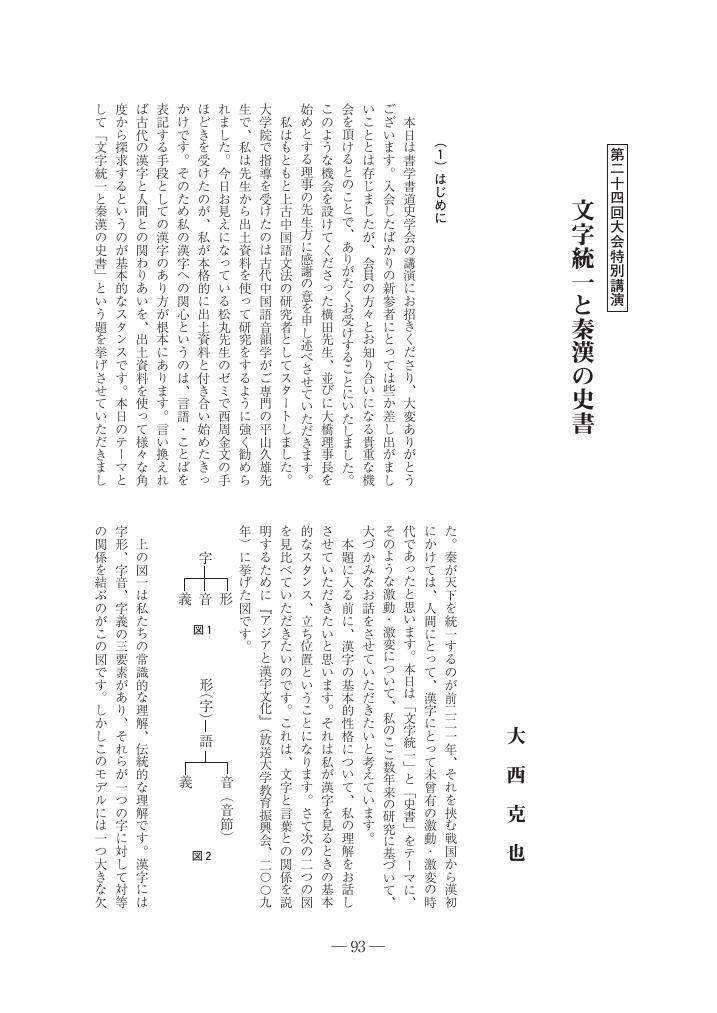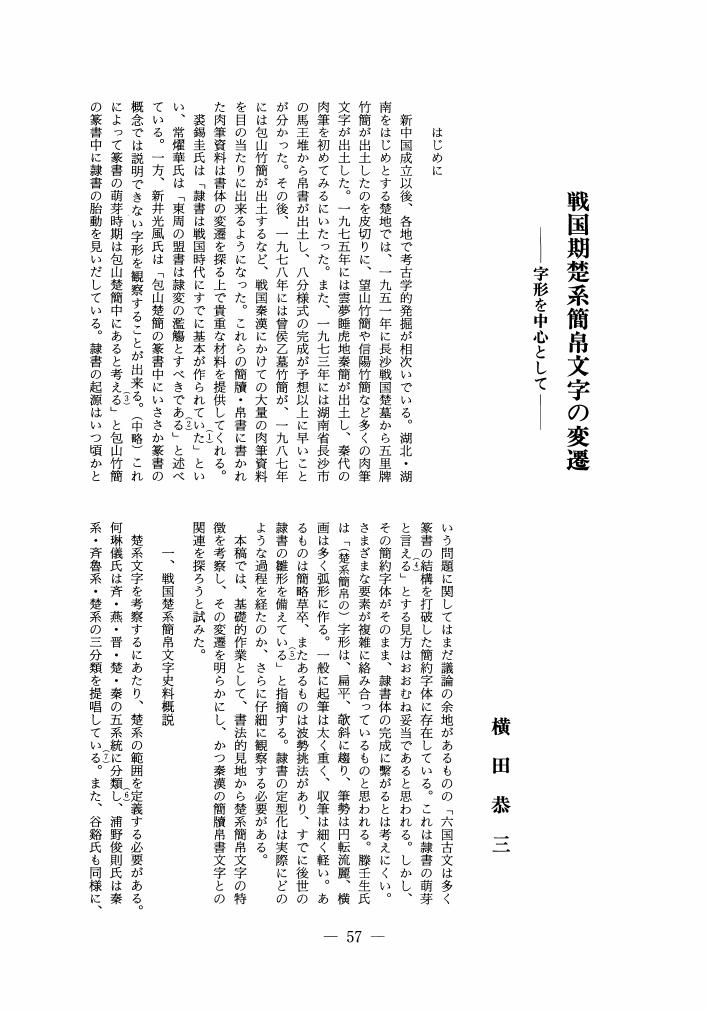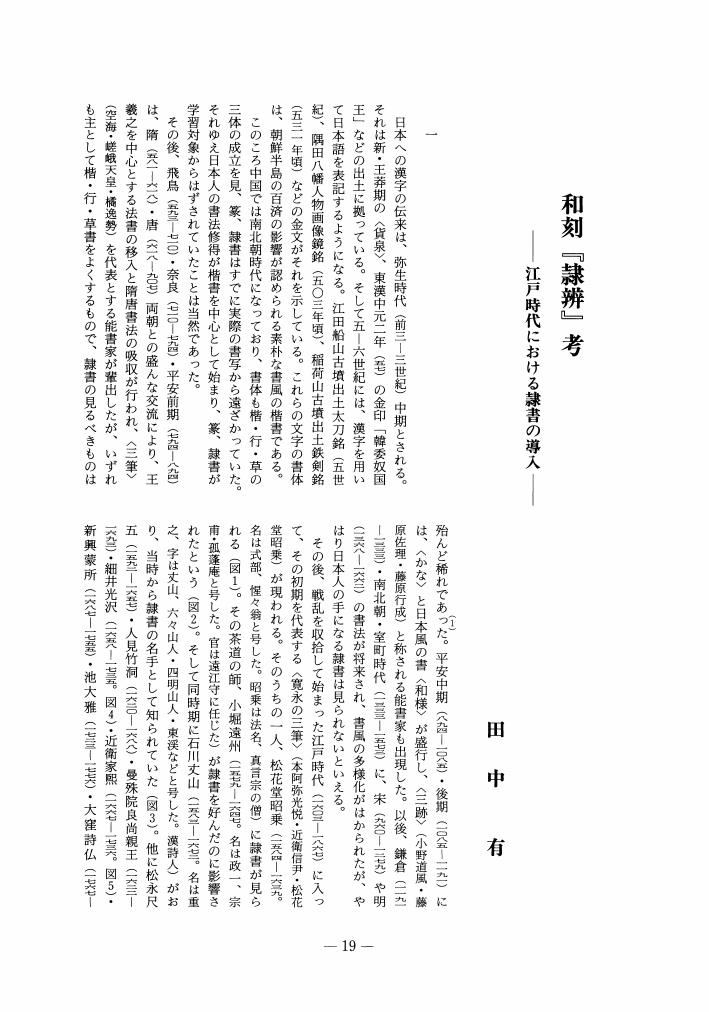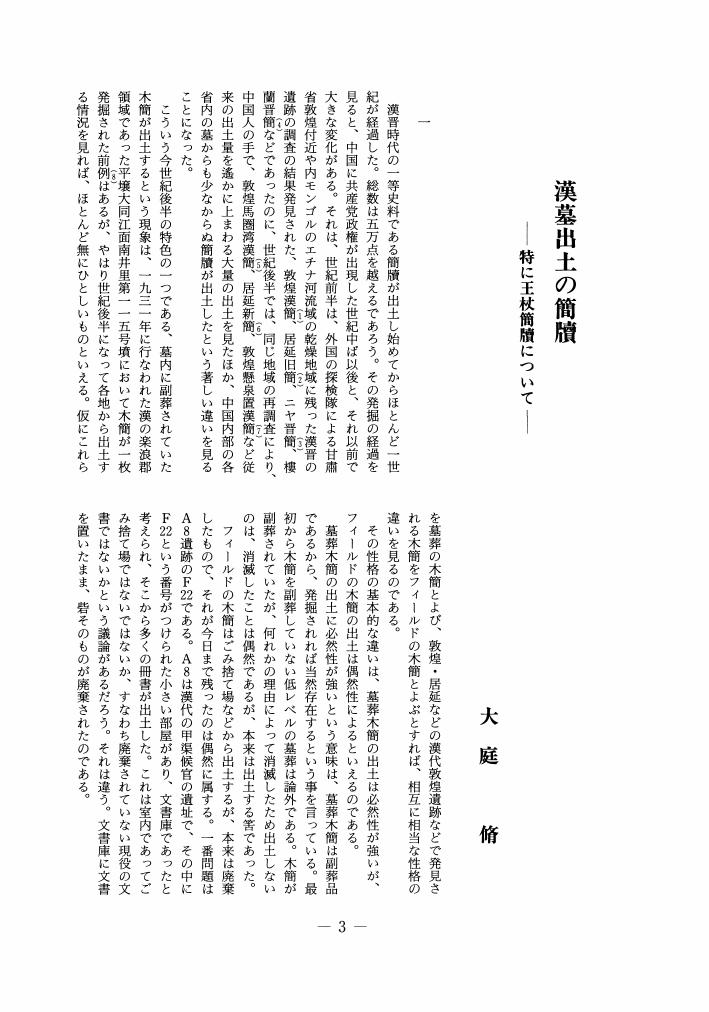1 0 0 0 OA 忘れられた碑の中から
- 著者
- 柴田 光彦
- 出版者
- 書学書道史学会
- 雑誌
- 書学書道史研究 (ISSN:18832784)
- 巻号頁・発行日
- vol.1998, no.8, pp.77-85, 1998-09-30 (Released:2010-02-22)
1 0 0 0 OA 書学書道史学会五周年記念・誌上座談会
- 出版者
- 書学書道史学会
- 雑誌
- 書学書道史研究 (ISSN:18832784)
- 巻号頁・発行日
- vol.1995, no.5, pp.55-96, 1995-06-30 (Released:2010-02-22)
1 0 0 0 伝承と生成のかたち
1 0 0 0 OA 手本体と写書体の形状的特質とその作品名称について
- 著者
- 木下 政雄
- 出版者
- 書学書道史学会
- 雑誌
- 書学書道史研究 (ISSN:18832784)
- 巻号頁・発行日
- vol.1991, no.1, pp.125-137, 1991-06-30 (Released:2010-02-22)
1 0 0 0 OA 後漢末期における書の諸相
- 著者
- 大橋 修一
- 出版者
- 書学書道史学会
- 雑誌
- 書学書道史研究 (ISSN:18832784)
- 巻号頁・発行日
- vol.2013, no.23, pp.1-8, 2013 (Released:2014-04-17)
There is a book called The Truth about Cao Cao's Tomb (Henansheng Wenwu Kaogu Yanjiusuo 河南省文物考古研究所 [Henan Provincial Institute of Cultural Relics and Archaeology], ed., Cao Cao mu zhenxiang 曹操墓真相, 2010; Japanese translation: So So bo no shinso 曹操墓の真相, 2011). This book covers the excavation of a tomb at Xigaoxue 西高穴 village that is considered to be Cao Cao's tomb and also discusses matters such as the truth about Cao Cao's death as recorded in historical sources. The Japanese translation is accompanied by a contribution by Watanabe Yoshihiro 渡邉義浩, who writes as follows: "The reason that I half believed that tomb no. 2 at Xigaoxue might be Cao Cao's tomb when I heard the first report lay in the location where it was discovered and the scale of the tomb. Why, then, did I half doubt it? The reason lay in the stone stele reading '魏武王常所用挌虎大戟', which the authors of this book have from the outset continued to cite as the prime evidence that tomb no. 2 at Xigaoxue is Cao Cao's tomb." With regard to this stele, Watanabe further writes: "I had the impression that the characters were not very well written, and I wondered whether Cao Cao would have had his name written in such a poor hand. For this reason I was half in doubt." In this article I essay a rebuttal of Watanabe's view regarding this point. This is because, in the history of calligraphic styles used at the time, the characters on this stele are written in one of the most typical styles used in inscriptions, a transitional style that emerged in the shift from the Han clerical script to the Wei clerical script. More specifically, the style of brushwork known as "wavy momentum" (boshi 波勢), a distinctive feature of the contemporary Han clerical script, has disappeared, and the characters on the stele are drawing closer to the style known as Wei clerical script, underpinned by stylistic harmony. By analyzing in detail the clerical script of the final years of the Later Han as it changed from the Han clerical script to the Wei clerical script, I demonstrate that this stele is written in a calligraphic style representative of the time when Cao Cao lived.
1 0 0 0 OA 文字統一と秦漢の史書
- 著者
- 大西 克也
- 出版者
- 書学書道史学会
- 雑誌
- 書学書道史研究 (ISSN:18832784)
- 巻号頁・発行日
- vol.2014, no.24, pp.93-103, 2014 (Released:2015-04-11)
1 0 0 0 OA 張芝草書の実相
- 著者
- 福田 哲之
- 出版者
- 書学書道史学会
- 雑誌
- 書学書道史研究 (ISSN:18832784)
- 巻号頁・発行日
- vol.2008, no.18, pp.17-30, 2008-09-30 (Released:2010-02-22)
1 0 0 0 OA 戦国期楚系簡帛文字の変遷
- 著者
- 横田 恭三
- 出版者
- 書学書道史学会
- 雑誌
- 書学書道史研究 (ISSN:18832784)
- 巻号頁・発行日
- vol.1998, no.8, pp.57-75, 1998-09-30 (Released:2010-02-22)
1 0 0 0 OA 張懐〓『書断』の史料利用と通俗書論
- 著者
- 成田 健太郎
- 出版者
- 書学書道史学会
- 雑誌
- 書学書道史研究 (ISSN:18832784)
- 巻号頁・発行日
- vol.2012, no.22, pp.13-26, 2012 (Released:2013-06-02)
Zhang Huaiguan 張懷〓 was a leading theoretician of calligraphy in the Tang, and in the Shuduan 書斷, his representative work, he develops his own theories about calligraphic styles and calligraphers on the basis of copious references cited from many written sources. Therefore, in order to gain an understanding of the Shuduan, it is essential to clarify his use of sources. In this article, taking into account past research, I carefully examine the actual use of sources in the Shuduan, and I educe the following general rules: (1) facts that are found in general (non-calligraphic) works possessing an established scholarly reputation, are widely shared, and are publicly recognized are used without citing the author's name or the book's title; (2) when utilizing the views of predecessors in discussions about matters regarding which there is no generally accepted view, the author's name is given in the case of works about calligraphy and the book's title in the case of non-calligraphic works; (3) criticism about works of calligraphy is utilized by giving only the author's name; (4) popular traditions about calligraphy that fall under (1) are utilized without giving the author's name or the book's title; and (5) popular traditions and manuals of calligraphy that are hardly worth consulting in scholarly terms are not utilized. This writing stance can be characterized as an orientation characteristic of orthodox calligraphic studies, which pursued the elegant and eschewed the vulgar, and from this there is also gained a perspective that divides calligraphic treatises over the ages into orthodox treatises that are worth consulting for their scholarlymerits and popular treatises that are not. But it is also a fact that there are a small number of passages in the Shuduan for which, contrary to this basic orientation, popular treatises may have been utilized. Furthermore, when one traces the history of the reception of the Shuduan in later times, it becomes clear that it drew closer to popular treatises in the way in which it was read, and its image eventually changed from its original image of an orthodox treatise on calligraphy to the exact opposite of a treatise with a popular coloration.
1 0 0 0 OA 江戸時代に舶載された法帖の研究
- 著者
- 大庭 脩
- 出版者
- 書学書道史学会
- 雑誌
- 書学書道史研究 (ISSN:18832784)
- 巻号頁・発行日
- vol.1998, no.8, pp.3-27, 1998-09-30 (Released:2010-02-22)
1 0 0 0 OA 和刻『隷辨』考
- 著者
- 田中 有
- 出版者
- 書学書道史学会
- 雑誌
- 書学書道史研究 (ISSN:18832784)
- 巻号頁・発行日
- vol.1994, no.4, pp.19-28, 1994-06-30 (Released:2010-02-22)
1 0 0 0 OA 漢墓出土の簡牘
- 著者
- 大庭 脩
- 出版者
- 書学書道史学会
- 雑誌
- 書学書道史研究 (ISSN:18832784)
- 巻号頁・発行日
- vol.1996, no.6, pp.3-15, 1996-09-30 (Released:2010-02-22)








